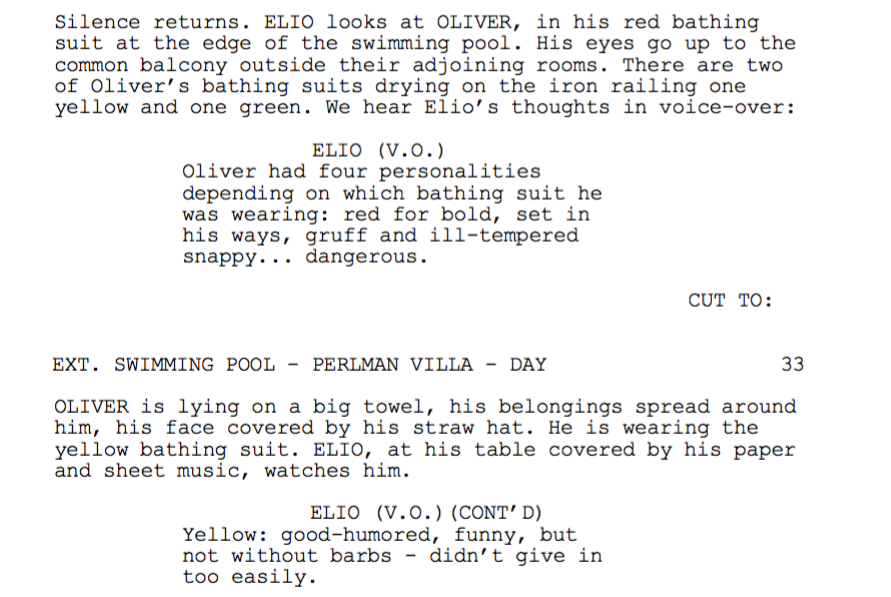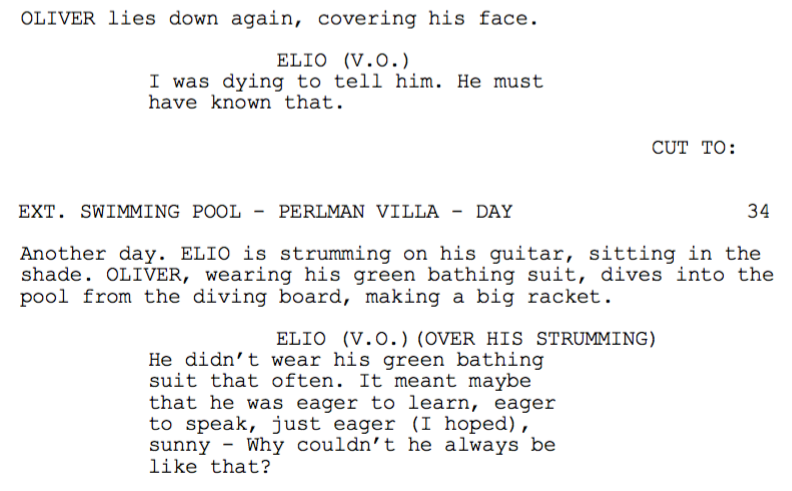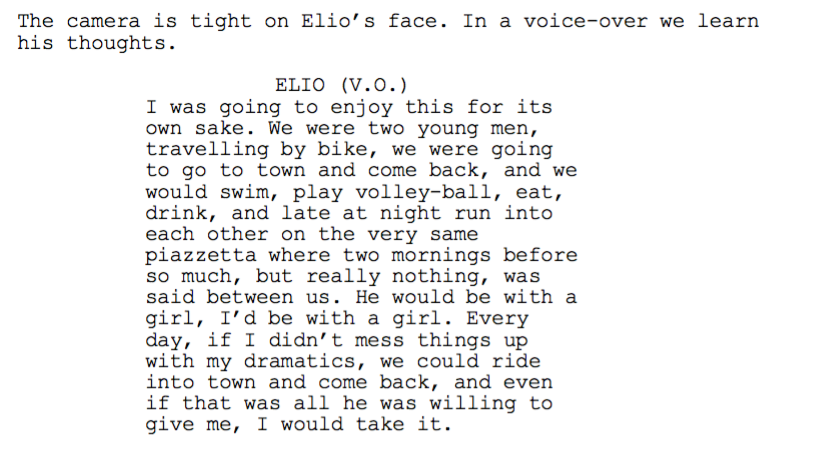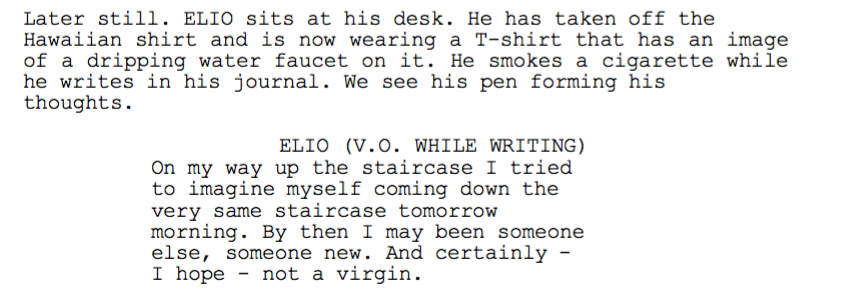Blueprints: "Call Me by Your Name"
 Thursday, November 30, 2017 at 4:13PM
Thursday, November 30, 2017 at 4:13PM Wrapping up Call Me by Your Name week at The Film Experience, so Jorge takes a look at its screenplay to talk one of the biggest and most successful changes made from the novel to the screen. It’s peachy.

Perhaps the most challenging aspect about adapting a book into a movie is converting the literary language into something visual; show with images what in the page is being told with words. This is especially hard if the novel takes place within a single character’s mind and perception, like “Call Me by Your Name” does with Elio.
One of the easier solutions (sometimes merited, others not so much) is translating the thoughts that the character has on the book into voice-over. It’s a simple, straight-forward way to effectively convey ideas and feelings.
Call Me by Your Name, the film, has been lauded (among many other things) for avoiding this go-to trope, and instead using action and visual cues to convey Elio’s quiet longing for Oliver, and the intimacy and slow simmer of their romance. However, it wasn’t always like this...
[Beware! Spoilers below]
Call Me by Your Name
Written by: James Ivory
Based on the novel by André Aciman
Screenplays go through many drafts. The finished product that the audience sees is the result of many rewrite sessions, small changes, and structural updates done to a story. Few scripts end up exactly as they started, and many don’t find its footing until the rewriting stage. It seems like this may have been the case with CMBYN.
While the structural bones and essential themes of the story were present in the original novel by André Aciman, translating them into cinematic language was a gradual process, as evidenced by a late 2015 version of screenplay that I was lucky to get.
The biggest difference in this draft from the final movie is its use of voice over. In this draft it appears in about five short paragraphs (scarce for voice-over standards), but the final cut completely got rid of it, probably because everything that it was saying, was already being depicted visually.

One of the (many) representative passages in the novel describes how Elio thinks he can guess Oliver’s mood by the color of his swim trunks, and how identifying that would determine the way his day would go. And this was originally described in a couple of voice over passages.
The core intention of that passage was to establish Oliver’s perceived emotional volatility towards Elio, something that in the film is quickly depicted by Armie Hammer’s perfect balance of curious approach, magnetic charisma, and sudden indifference, as well as by Timothée Chalamet’s hesitant reactions. The swim trunks are a fun metaphor, but one that is ultimately not needed.

There are a couple of other voice-over moments in this draft. One that literally describes Elio and Oliver doing various activities throughout the summer (“We were going to go to town and we would swim, play volley-ball, eat, drink, and late at night run into each other”), and Elio’s doubts about its permanence. This is a paragraph that was easily translated into quick scenes; it’s something the actors can physically do without a narration explaining it.
The other one expresses Elio’s hopes about what might happen after spending the night with Oliver. The actions described in this scene (him writing on his journal while smoking a cigarette) is a recurring image through the actual film; one that is made more poignant without a voice-over. It’s not really important to know what he is writing to understand that he is overwhelmed with desire by that point.

***

However, the biggest change comes in the final scene; a scene that has been considered one of the most powerful and impactful moments of the film. On the final version, as the credits roll and Sufjan Seven’s “Visions of Gideon” plays over, Elio stares at a crackling fire after a heartbreaking phone call with Oliver, and tears up, overwhelmed by the moment.
But this scene was completely different on the page. Here, as he lights up the Hanukkah tree (still overcome with emotion), a voice over tells us that even though Oliver was his first love, it was not his greatest. That would come later. Not only does this explicit (and weirdly sequel-setting) narration takes away from the nuance and bitter sweetness that lives in the scene, but keeping it would have taken focus away on the tremendous acting work that Timothée does in the final sequence. The pain of the moment, of that specific moment, is intrinsic to the themes of the movie. Removing the voice-over in that particular sequence elevated the movie to a different plane.

It is also worth noting that the voice-over narrator is supposed to be an older Elio, not the young, love-stricken one, that is retelling the story of the movie as anecdote. Since the movie is so grounded in a present tense, no voiceover highlights a theme of immediacy that is essential: how much we feel feelings in the moment, and how overwhelming they are.
It is sometimes easy to forget that movies are years-long process, and that the brilliance we experience on theaters might have taken a while to acquire. Call Me by Your Name is the perfect example of a novel adaptation that took its cautious steps to adapt the literary language to the screen, and while it tried to go a well-trod way, it found its footing along a more unusual path.
Sometimes, fewer words say so much more.




Reader Comments (6)
Oh, I'd KILL to see any of Ivory's drafts for CMBYN to compare to my own from ten-eight years ago!!!
This was a great read as well, as there's less hosannas and more actual discussion about the film-craft on display.
Gah, stop taunting me! I don't live in LA anymore and so haven't been able to see this yet. It seems everyone here is either there or NY, because where the heck else is this film currently???
This is the scond post in the week that spoils Call me by your name so I had to skip them. I wish it premaires soon in South America.
Love your site Nathaniel. Best wishes for you and ypur colleagues writers.
Really glad they removed the voiceover. It really grounds the film in the present which makes everything feel more vibrant and urgent.
Is there anywhere online where I could access the actual CMBYN screenplay?
There is a fair say, "Quantity doesn't matter, but quality matters." The same goes for assignment writing. Students who take philosophy as a subject in their college years are often concerned about "who will help my geography assignment?"